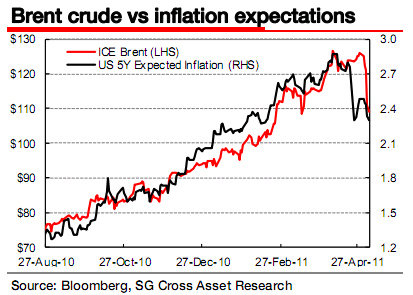Here’s more evidence that oil is the most important input in inflation expectations. As you can see in that chart below, inflation expectations and brent crude prices have correlated near 1:1 over the last year. As I’ve previously shown, this rise in motor fuel accounts for the majority of the spread between core CPI and the headline. Societe Generale says the recent hiccup in oil prices is likely temporary and not the start of a new bear market:
Conditions for a correction had been emerging over the previous weeks.
Several key factors drove the correction, which affected most commodities, not just oil:
– Macroeconomic concerns about the US, Europe, and China have increased.
– Worries about a “hard landing” in China.
– Markets increasingly focused on the end of US QE2 program: end of excess liquidity injection, leading to declining inflation expectations and stronger dollar, both bearish for crude oil prices.
– Markets increasingly concerned about oil “demand destruction” as a result of high prices: it will be moderate and limited to the US but weak US demand data has affected market psychology.
– Oil markets have focused less on the MENA geopolitical situation.
That would all mean an increase in inflation expectations, however, the contrarian call (that ECRI is making) says a global slow-down is on the horizon. And with it we’re likely to see lower oil prices and inflation expectations. But make no mistake – this cost push inflation due to motor fuel is merely reallocating spending from one segment of the economy to another. On the whole, it is likely to be accompanied by lower growth and not a surge in overall inflation.
Mr. Roche is the Founder and Chief Investment Officer of Discipline Funds.Discipline Funds is a low fee financial advisory firm with a focus on helping people be more disciplined with their finances.
He is also the author of Pragmatic Capitalism: What Every Investor Needs to Understand About Money and Finance, Understanding the Modern Monetary System and Understanding Modern Portfolio Construction.


Comments are closed.